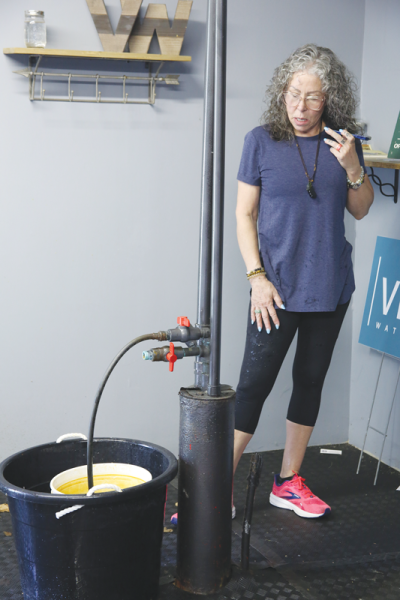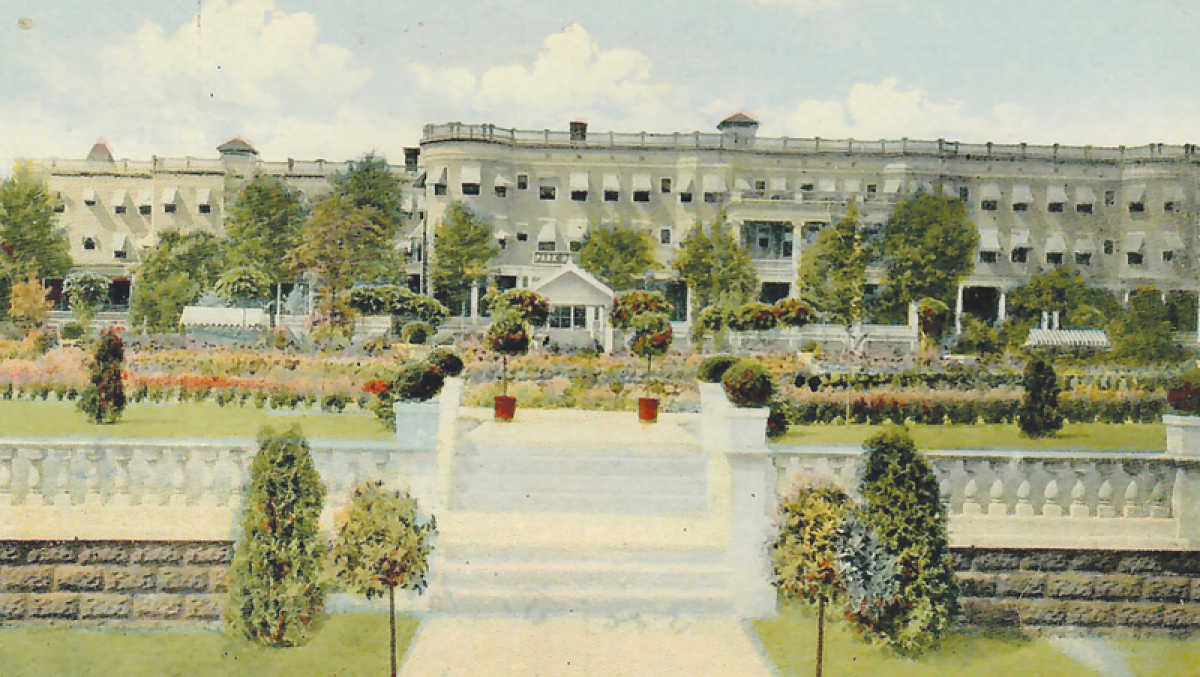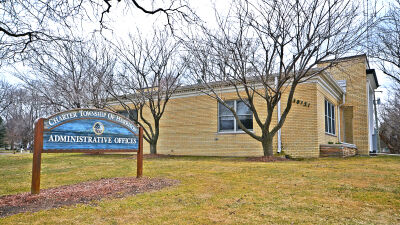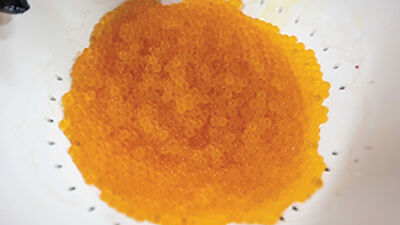
Lois Lombardo, owner of the Olympia Salon & Spa and the Park Well, discusses the well’s operation over the phone with Lisa Saylor, who worked with the well’s prior owner.
Photo by Dean Vaglia
MOUNT CLEMENS — It is Friday, May 17, and Lois Lombardo is in the fight of her life.
The owner of Olympia Salon & Spa on Cass Avenue is trying to work her new water pump in a shed on the other side of the city, but nothing is going right. She flips switches, turns valves and repositions a hose in hope of getting the pump to send its water to the surface.
Suddenly, a breakthrough: The pump roars to life and bathes Lombardo and the rest of the shed with dirt-brown water stinking of rotten eggs, a scent that hangs in the air for the next hour. From the senses alone, it is hard to believe anyone could find value in extracting such a liquid, but Lombardo knows what she has. It is the reason she came to Mount Clemens, and it is the key to how she plans to revive the century-old industry that put Mount Clemens on the map.
Welcome to Bath City
Mount Clemens is known as Bath City, or at least it is to its residents. Anyone trying to hunt down the signs of a citywide bathing industry have to look hard to find anything beyond baked-in echoes to verify this odd claim to fame, and even then, all they have to work with is a preserved pump in Clemens Park and a historical marker on the east side of Select Specialty Hospital. For something that the city clings to as its identity, the lacking modern footprint of the bath industry almost seems inscrutable. But in some ways, it is fitting that an industry that began as a boom would leave so little behind.
In the 1870s, speculators came to Mount Clemens on the hunt for oil. Their drills found murky liquid beneath the city, but not the sweet crude they hoped for.
“We did not have oil, but we did have some amazing mineral water that had so many different minerals in it,” said Beverly Bishop, a Crocker House Museum docent.
The Original was opened in 1873 by physician Henry Taylor, who capitalized on the interest kicked off by local flour mill owner Dor Kellogg, who attributed his cured eczema to bathing in the water in 1870, and by physician Abner Hayward, who prescribed baths to patients with rheumatism. As word spread of the city’s healing waters, more bathhouses sprung up and more people came seeking treatment. With recommendations calling for people to regularly bathe in the waters, guests would book nearly month-long stays in local hotels, prompting the creation of a hospitality industry featuring restaurants, big bands, symphonies, theaters and other things to keep the guests entertained throughout their stay.
And if the idea of a month-long hotel stay featuring daily spa visits and regular entertainment sounds expensive, that is because it was. Bishop says it cost 75 cents to take a bath in 1913, or about $24 when adjusted for inflation. Add in the costs of the hotel stays and nightly shows and the ideal Bath City visit begins to snowball into an expensive endeavor.
“It was kind of ritzy, and you had to have a whole 21 days of vacation time,” Bishop said. “So I would say it would have been a higher class (activity), but anybody could sign up for it.”
Key to the rise of the bath houses was the city’s rail connection and proximity to Detroit. That allowed Mount Clemens to capitalize on the resource and gain the clientele and popularity that eluded other communities with mineral water springs that were simply too remote.
“We were lucky because there were trains that came from New York City across to Detroit and then we had spurs that went straight up to Mount Clemens,” Bishop said. “Thomas Edison was really one of the first people working that spur in 1859 and it was like a hub just above Detroit, and much nicer than Detroit was at the time … Midland tried to do that, but nobody could get there because there were no trains. They had to go overland by buggy and there were no roads for cars when they came in, so Midland went the pharmaceutical route and Dow Chemical ended up using the mineral water for their purposes.”
An exact count of how many bathhouses existed is hard to determine. The nature of the industry meant many of the houses would pop up and go out of business fairly quickly with the only solid evidence of a bath’s existence being advertisements and whichever ledgers and letters have been preserved from over 100 years ago. A 1993 pamphlet about the industry printed for the 175th Mount Clemens anniversary places 11 baths within the city’s limits, including the Saint Joseph Sanitarium, now known as Select Specialty Hospital.
Ownership of bath houses was fairly diverse, with Black resident George Hutchinson opening the Eureka on Welts Street near Clemens Park, a decision believed to be attributed to a 1905 news story about a Black university graduate being refused service by the city’s baths. Julia Miller Thome operated the Monroe Hotel and Plaza Bath House after her brother, Fred, died in 1923. Throughout the 1910s and 1920s, several Jewish New Yorkers made the trip to Mount Clemens, took ownership of bathhouses and built a Jewish community in the city. Mount Clemens was the Bath City, and everyone wanted their share as either a bather or an operator.
The tradition continues
Lombardo, who wanted to carry on the bathing tradition, was attracted to the mystique of the medicinal Mount Clemens waters in 1998.
“I had always wanted to own a salon and spa,” Lombardo said. “I had no experience in owning a business, but this was my dream, and I was very drawn to Mount Clemens. I grew up in St. Clair Shores, but I had always heard about Mount Clemens’ history with the baths and the hotels, and I thought Mount Clemens was where I was supposed to be. I just knew it.”
Lombardo opened up the Olympia Salon & Spa — a name derived from one of the major baths of the peak era — originally on Main Street, keeping mineral baths as part of her offerings from day one. Being the only bath house in town was novel for Lombardo’s Olympia as the industry was well dead by the turn of the millennium. While the rise of pain medication is attributed as one of the reasons for the industry’s decline, Bishop knows the exact day the fate of the baths was sealed: Tuesday, Oct. 29, 1929.
“When the stock market crashed in 1929 and we went into a severe depression, they started closing down baths and hotel rooms because they couldn’t rent them,” Bishop said. “People weren’t coming up. They didn’t have disposable income. Everybody was looking for different ways at that time, and that was the big demise. Oct. 29, 1929, was the death knell for Mount Clemens.”
World War II necessitated a shift to manufacturing in Mount Clemens, with industry quickly overtaking hospitality, all while bath houses were left with dwindling patronage. Owners would leave their failing houses to rot, letting fires consume buildings and run off with the insurance payout. Fewer and fewer bath houses and wells remained in operation. Some wells were filled and capped with concrete. Others were built over and rendered inaccessible. Virtually all of them were made inactive by the 1970s.
“When the smell evaporated from Mount Clemens, you knew it was gone,” Bishop said. “Up until then you knew it was there and that bath continued, so it definitely continued though the 1960s — and then it was done … It went from 1930-1960 limping along, and then it ended; the smell went away.”
One well, however, survived the decline. The Park Hotel’s well, once controlled by businesswoman Julia Miller Thome, changed hands over the years before landing in the control of Susan Gans. Born in Detroit and a retail broker in the Birmingham-Bloomfield area, Gans acquired the Park well in the 1990s and used it to build the Vitl Waters skincare products company.
Gans held her cosmetic products to a high standard, requiring the significant use of the mineral water as an ingredient in her products due to the medicinal legacy of the water. Lisa Saylor, former Vitl Waters director of sales, says a major cosmetics company tried to buy out Vitl from Gans, but the sale was called off at the last minute when the contents of the products were in question.
“It was a pretty significant deal, and when it got right down to a couple days before they were closing on a deal, the one question she had been asking them was how much of the water they were going to be putting into each product,” Saylor said. “They had delayed an answer and eventually came down to the end, and they answered they were going to put a drop from a dropper (into each product) and put Vitl Waters on the label, and she turned down a deal that could’ve changed the business. She said no because she understood the value and the impact of what this product had done for people, and she wasn’t willing to tarnish the name because someone else thought it would be a good idea to put our name on something nobody was going to feel a difference in.”
Gans and Lombardo were close colleagues. Olympia Salon & Spa — which moved in 2007 to a building at 117 Cass Avenue that is from the city’s bath era and resembles the original Olympia — bought water from Vitl for use in its mineral baths, which consist of a 50-50 mineral-to-tap water combination. When Gans died in 2022, Lombardo was the most obvious choice to take over the company and the deed to the Park Hotel well.
“It’s been very exciting for Lois to take over, especially because she had a longstanding relationship with Sue and with Vitl Water,” Saylor said. “She understood the benefits, which I think is why there is so much value in the fact that she is picking up the torch and keeping it going, because they really are great products, and the history of the well is so amazing. It’s like nothing else in the world.”
Standing in the Park well’s modest and sulfuric-scented shed on a May afternoon, Lombardo goes over the situation she’s in. Just across Park Street looms the Victory Inn Motel, which will be demolished soon for a new 101-unit apartment complex. It is in the ruins and soon-to-be rubble of the Victory Inn that Lombardo sees an opportunity.
“What my vision is at this point is I’m going to be looking to expand and create an actual soaking experience here on this lot, where they can go back to soaking in the black, murky water right from the well like they did back in the late 1800s and early 1900s,” Lombardo said. “What I’m planning is a smaller type setup. A little bit more rustic, not huge and elaborate. It would be more back to the rustic experience of soaking in the water. It’s me having a larger addition built on this garage and making it into a place that people could come soak in.”
Her plan to effectively revive a long-dead industry is nothing short of idealistic and will certainly take a great effort, but may not entirely be a moonshot. After all, the land is already zoned for commercial use. Time will tell whether Lombardo is successful at establishing a dedicated bath house in the 2020s, but Saylor believes it is possible.
“I think that people are always in a hurry to do the next big thing, and then lose sight of what was working before,” Saylor said. “I think that there is a large group of people now that are wanting to get back to what is natural, and I think this will be something that is very exciting. I think it will be an exciting thing for the city of Mount Clemens and for the people that will benefit from the water.”
Mineral composition of the water
The top eight most common minerals in Mount Clemens mineral bath water, measured by grains within one gallon
sodium chloride - 5713.7
calcium chloride - 4678.8
magnesium chloride - 2406.8
potassium chloride - 468.9
calcium sulfate - 91.1
magnesium bromide - 71.1
sodium sulfate - 40.6
ammonium chloride - 10.3
— Source: Mount Clemens 175th anniversary pamphlet, published by the city in 1993 and provided by the Crocker House Museum & Gardens
 Publication select ▼
Publication select ▼
















